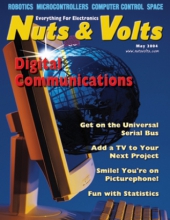Nuts and Volts Magazine
Features
Last month, I showed you how easy it is to build logic circuits using a Xilinx CPLD (Complex Programmable Logic Device). This month, we'll dig into a more sophisticated design. In particular, I'll show you how to build a useful piece of test equipment — a "logic scope." This is a poor man's logic analyzer. The logic scope reads four bits of digital data, records them, and then displays the waveforms on a normal oscilloscope.
If you have a device that you want to use in a local network or on the Internet, one of the decisions you’ll need to make is how the device will exchange information with other computers in the network. Many devices host web pages that display information and enable users to send input, but web pages aren’t the only option.
USB is the answer to the development of all the new external peripherals for the PC platform. USB is low cost, fast, easy to use, bi-directional, and capable of real time data transfer of voice, audio, and video. Currently, USB 2.0 has a bandwidth of 480 Mbps, which is 40 times greater than the previous version — USB 1.1 — with a fully compatible bandwidth of 12 Mbps.
Projects
This project provides a wired remote control for certain members of the Archos family of hard disk-based Jukebox MP3 players and recorders. Key features of the design are...
When I was 13, my dad came to me with a challenge to build something my grandpa designed and called a BX24-AHT Transmogrifier. This was my first attempt at such a big project — much less a project that involved soldering. Like most 13-year-old boys, I wasn’t too interested because I thought the idea sounded boring, but, in the end, I agreed to take on the job. It started out slowly, mainly because my dad and grandpa were trying to teach me what each part did. Eventually, we got to the soldering
Have you ever wanted to add an inexpensive video text display to your project? Well, now you can!
Columns
In The Trenches
by Gerard Fonte
IN THE TRENCHES
Statistical analysis is an extremely powerful tool. It is important for an engineer to be familiar with techniques and methods of statistical analysis. Statistical procedures are often used to define reliability, but they are also very useful in signalprocessing.
Let’s Get Technical
by James Antonakos
LET’S GET TECHNICAL
I have chosen to finish my three-part fiber series with an application that uses a fiber optic cable as part of a high-frequency oscillator. Called a Fiber Optic Ring Oscillator, it makes use of a length of fiber to generate a square-wave signal; the frequency of its oscillation depends on the length of the fiber and the speed of light inside the fiber.
Micro Memories
by Edward B. Driscoll, Jr.
MICRO MEMORIES
Using the telephone is such a hassle these days; women have to make sure their makeup and hair is just so and all but the most Cro-Magnon of men want to appear clean-shaven and well-groomed when calling their wives or parents.
Near Space
by L. Paul Verhage
NEAR SPACE
Now that you have a near space (NS) craft, what experiments can you perform with it? Since it has a simple tracker — not a flight computer — there are some limitations. There are many experiments that function on their own; however, before you can process your science results, you need to understand the format of the data transmitted by the Tiny Trak 3 in your NS craft.
Personal Robotics
by Mike Keesling
PERSONAL ROBOTICS
Let’s face it, the real core of robotics is information processing. What is done with the information a robot gathers truly determines its behavior. At the simplest level, that information could be a series of commands and times to perform them. Even at that level, there is still sensing going on; in this case, we are sensing the ticks of a clock. While this is a great start, watching your robot roll off your desk or ram into a wall because it had no sense of its surroundings gets old really fas
Q&A
by TJ Byers
Q&A
In this column, I answer questions about all aspects of electronics, including computer hardware, software, circuits, electronic theory, troubleshooting, and anything else of interest to the hobbyist.
Stamp Applications
by Jon Williams
STAMP APPLICATIONS
One of the great things about my job — aside from the fact that I get to work with BASIC Stamps all day long (and get paid for it!) — is the customer contact I am able to have. Almost all of my contacts are very friendly and find what I get to do here with Nuts & Volts useful — sometimes even a bit entertaining. Often, I get messages that are cries for help and I always enjoy helping, when I can. From time to time, a customer will alert me to a part that I hadn’t previously worked with...
Just for Starters
by Mark Balch
Reading Schematic Diagrams
Reading and interpreting schematic diagrams is an important skill for anyone who wants to work with electronic circuits.

